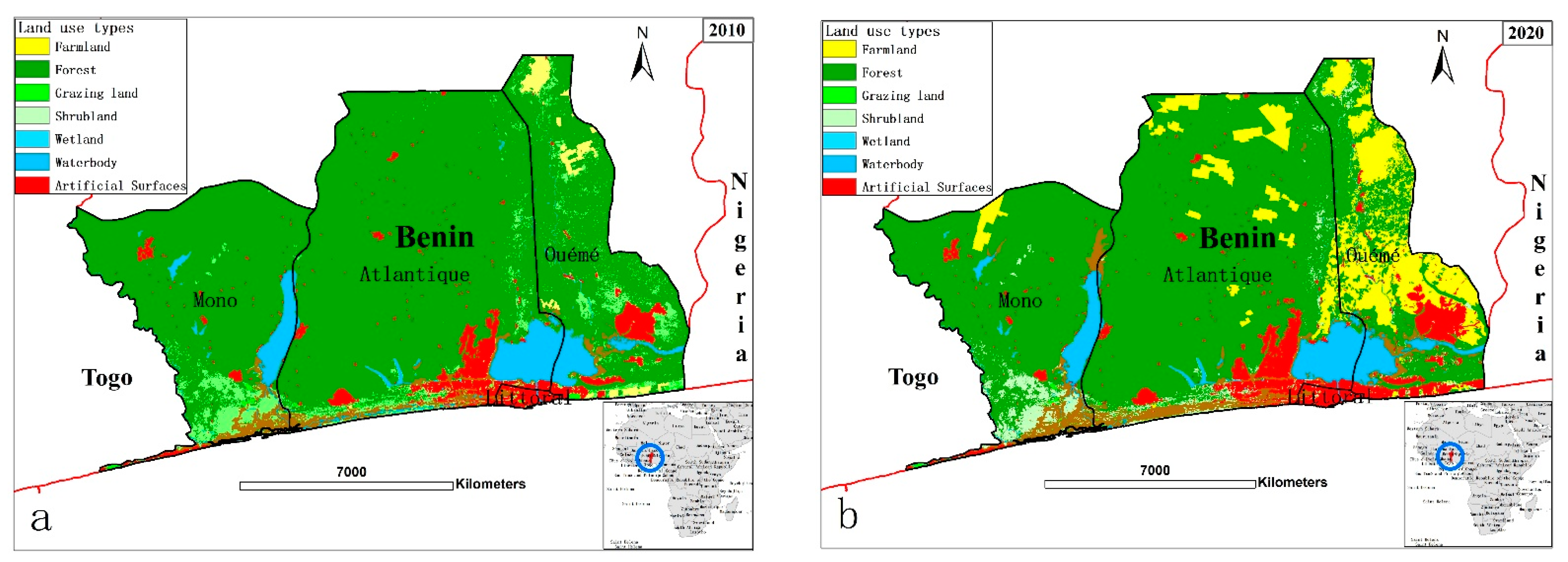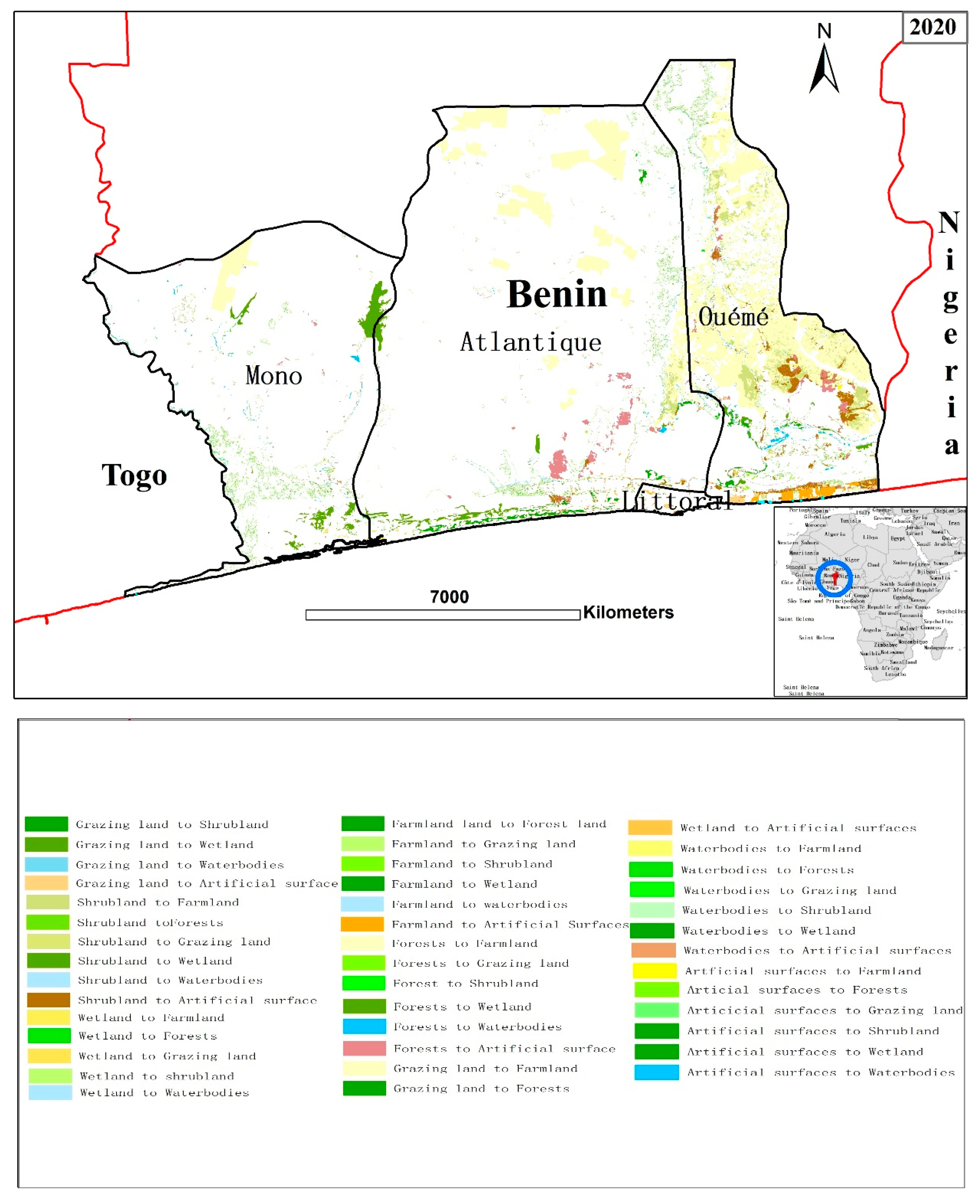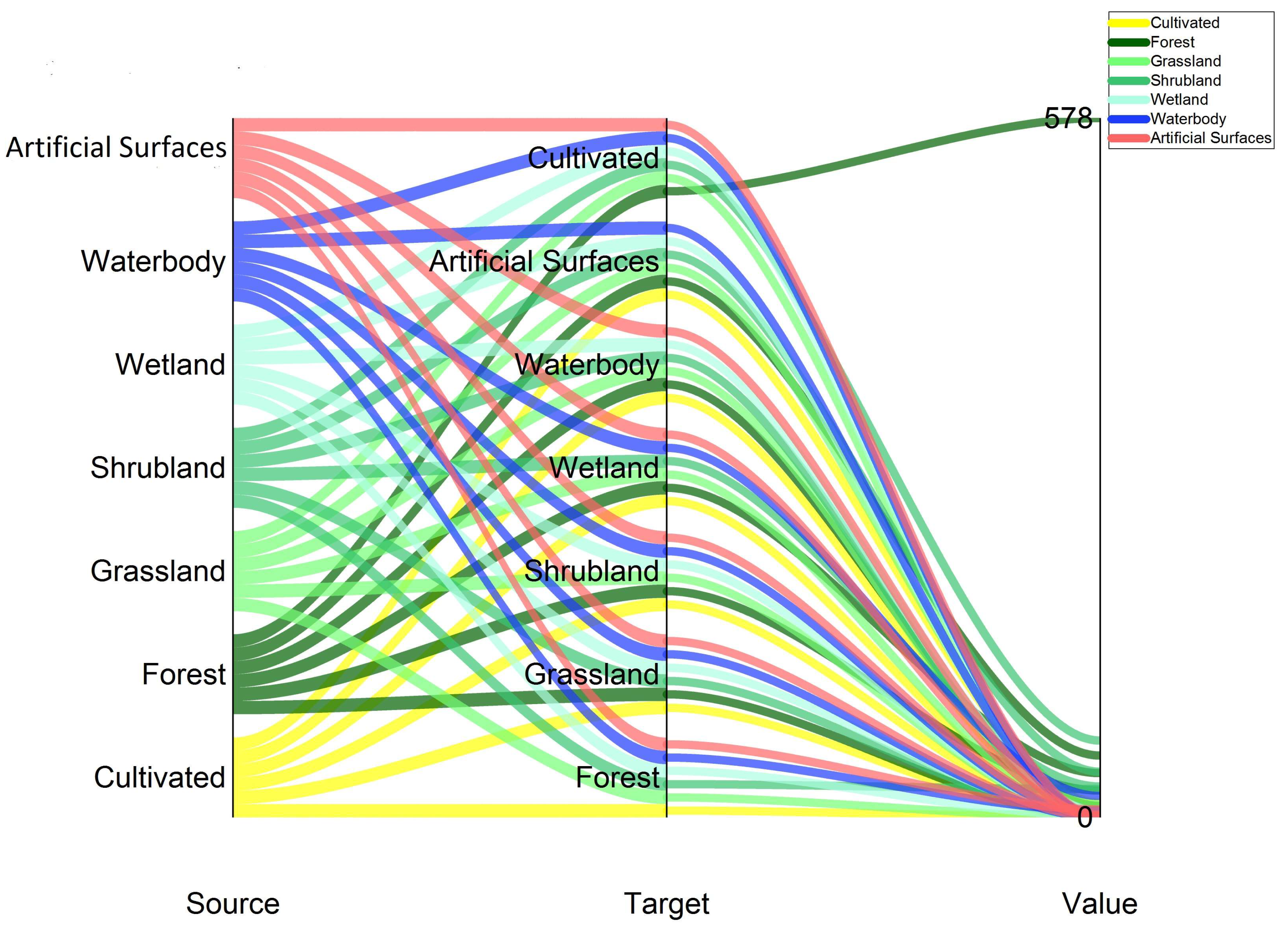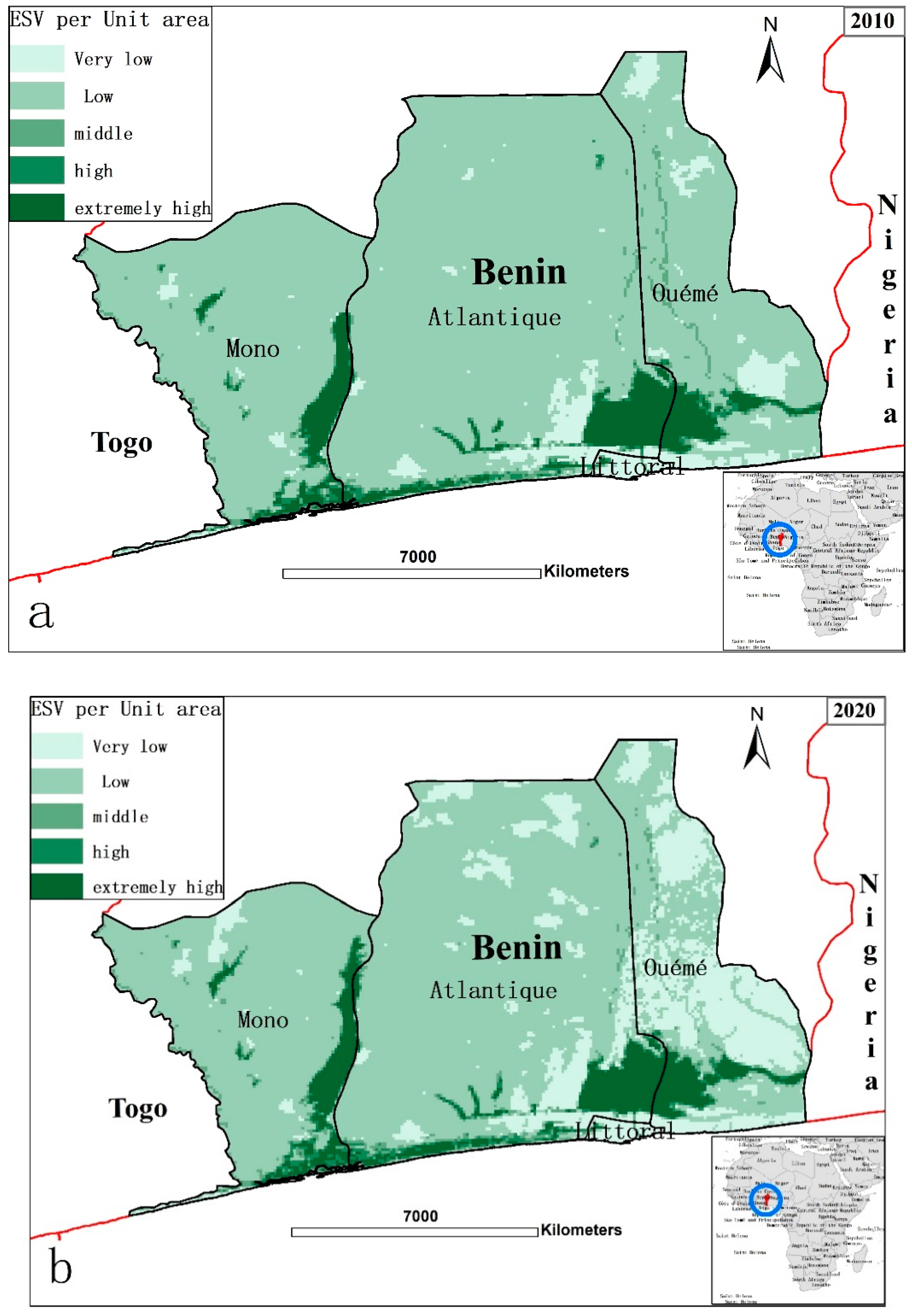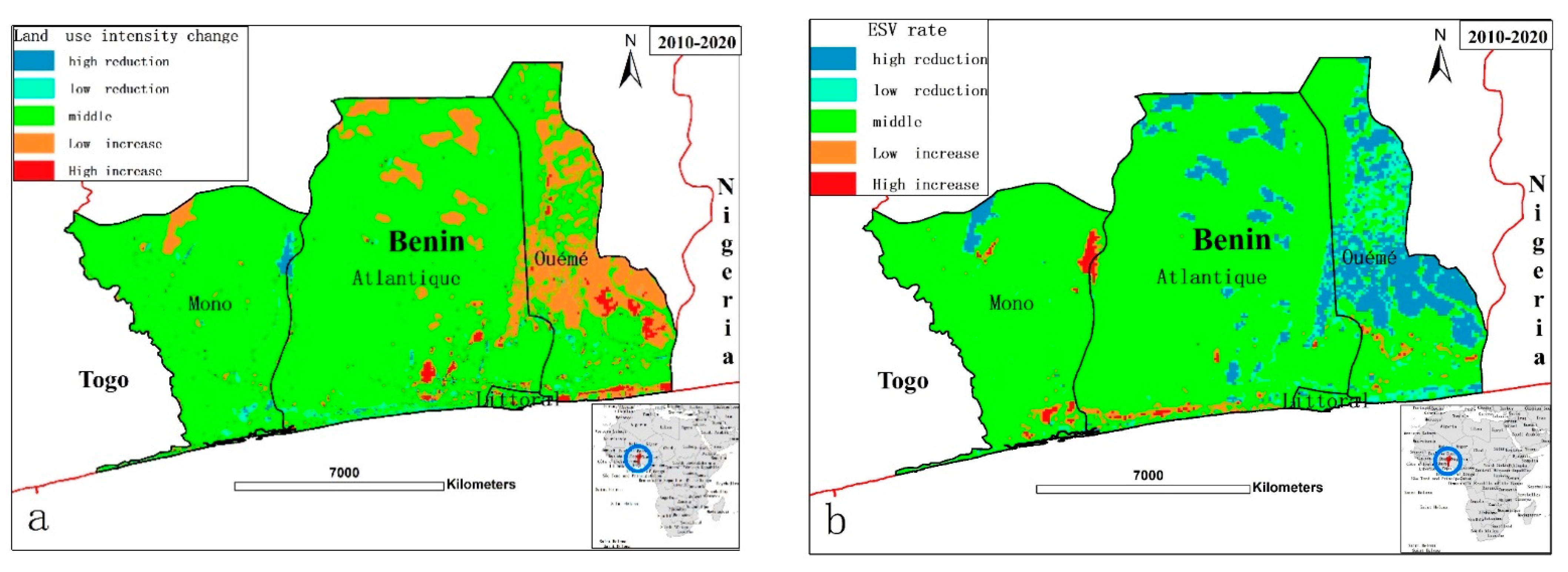1. Introduction
The concept of ecosystem services brings challenges in evaluating and balancing between sustainable socio-economic development and natural resources protection. Scientific assessment of the concept has concerned scholars around the world since the last decade, and it has recently been discussed in the context of Sustainable Development Goals (SDGs), which call for synchronized international efforts towards a more resilient and rational use of ecosystem services [
1,
2]. However, integrating ecosystem services and socio-economic characteristics into decision-making processes remains a challenge. Ecosystem services represent goods and services provided either directly or indirectly by the functions of the ecosystem on which human existence depends [
3,
4]. For instance, the provision of ecosystem services can directly affect changes in the extent and composition of forest, wetlands, river, and agricultural land.
The assessment of ecosystem services covers the loss or benefit costs of preserving a given amount or quality of an ecosystem service and is an integral part of the conservation decision-making process [
5,
6]. Two methods of evaluating ecosystem services have been widely used to estimate the ESV: First, the contingent economic approaches concerning market prices, travel cost, production approaches, and opportunity costs [
7,
8]. The second technique is the land-use proxy-based method, or the benefit transfer approach (BTA). The BTA combines remote sensing and GIS technologies to estimate the ESV and map the services’ distributions [
9,
10]. The BTA has been extensively used by scholars due to the lack of primary data and limited financial resources [
11]. The BTA offers immediate information to decision-makers on various aspects of policy actions and strategies for the sustainable management of land resources, and it has been widely used by researchers to assess the values of ecosystem services at different spatial scales, such as countries, provinces, cities, urban agglomerations, and watersheds [
6,
12].
Coastal zones are the transitional areas between sea and land and are an important geographic zone both in terms of resources and human habitation [
13]. They are environmentally complex and sensitive, with coastal ecosystems being among the most productive on Earth [
14]. They sustain the stability of coastal aspects, represent potential hazards, and enable sustainable economic development [
15,
16]. Nevertheless, coastal ecosystems nowadays fall among the most affected ecological areas due to the continuous intensification of anthropological activity, including not only coastal developments such as land reclamation, but also pollution from upland agriculture and industry [
16,
17]. Coastal ecosystem services are more liable to suffer irreversible damage caused by human activities than that caused by biophysical drivers [
18,
19]. These changes are pronounced in West African coastal areas, particularly in low-income coastal areas, with LULC changes accountable, directly or indirectly, for the degradation of coastal zones, their ecosystems, and their capacity to produce sustainable resources [
20,
21]. Socio-economic activities, such as urbanization associated with coastal population growth, traditionally occur parallel with LULC changes (mainly from forests and grassland to farmland and built-up areas, and the conversion of coastal wetland into farmland [
22]. Globally, the conversion of natural ecosystems into agricultural land increases food production, housing, and other goods but also may generate an accompanying decline in the provision of several ecosystem services. It has been estimated that 40% of the agricultural land of the Earth’s surface area has been converted by forests being cropped, due to the increasing human population and economic development [
23]. Consequently, the ecosystems sustained by these natural areas are lost as they shrink.
Changes in LULC are among the main driving factors of ESV fluctuation [
23,
24]. LULC changes impact the status and integrity of an ecosystem, which affects its functions and the services it provides to humans [
25]. The assessment of ESV from the perspective of LULC change has significance in evaluating the impacts of land-use changes on a coastal ecosystem [
26]. Consequently, deepening our understanding of the importance of coastal development decisions and the consumption of coastal resources will help us to better use ecosystem services.
Benin is a West African country located in the Northern hemisphere. It is bounded by Togo to the west, Burkina Faso and Niger to the north, Nigeria to the east, and Bight of Benin to the south. The coastal zones of Benin constitute important coastal ecosystems containing various coastal wetlands, mainly composed of mangroves, that are important for the maintenance of biodiversity and also for their role in sustainable socio-economic development [
27]. However, the current strategies of coastal zone management are dealing with LULC changes, as well as the degradation of the natural coastal ecological environment [
28]. Under the current situation, though, the assessment of ESV related to LULC changes in Benin’s tropical coastal areas has been relatively scarce and has been limited to several small coastal areas comprising a few districts of Benin [
28,
29], leaving the understanding of LULC within the broad coastal areas limited. To date, there has been no assessment of the impacts of tropical LULC on ESV across the coastal zones. There is still a lack of fine resolution spatial description of the effects of human activities on ESV. Additionally, the method of deriving ESV from local coefficients modified for the study area has limitations. To overcome this, this study covers the whole tropical coastal region of Benin and uses the benefit transfer method and satellite imagery data to analyze LULC changes in the tropical coastal region of Benin within a ten year period. We provide a scientific basis for local and regional actions and policymaking strategies that can be employed to ensure the sustainable management and rational use of the coastal ecosystems.
4. Discussion
4.1. Land-Use and Land Cover Changes Impacts on Ecosystem Services Value
The spatial distribution of land-use intensity from 2010–2020 was consistent with the spatial distribution of the ESV change rate from 2010–2020 (
Figure 7). The ESV of regions with a high land-use intensity index significantly reduced during the 10 years, indicating that the land-use changes influenced ESV significantly under the current urbanizing coastal zone of Benin. Over the last 10 years in our study area, significant changes in LULC patterns have influenced the quality and quantity of ecosystem services, as well as the provision of functions. LULC changes caused changes in the structures and functions of the ecosystem services through the interaction of multiple aspects [
40,
41].
Between 2010 and 2020, a clear increase in artificial surfaces and farmland and reductions in forest land and waterbodies were recorded. The reductions in forest land and waterbodies are reflected in the fluctuations in total ESV. Traditionally, deforestation along the coastal zone involves clearing land for farming activities, as well as developing settlements and infrastructure. Consequently, the transition of land use is observed between forest and artificial surfaces. The decline in forest area is an important contributor to the total ESV and may have led to the reduction of the provision of ESV.
The reductions in forest land and waterbodies are reflected in the fluctuations in total ESV. Our results cohere with those of previous efforts to quantify the ESV along the coastal zones of Tanzania by Ligatea et al. [
38] and Abu Yousuf et al. [
42] in Bangladesh’s coastal areas, which revealed that vegetation cover also underwent a net decrease (8.26%). They also showed a reduction of 15.23% in the ESV of the Zhejiang coastal area, due to a 25.13% reduction in forest land [
24], from USD 1.33 million to USD 1.07 million due to the loss of vegetation (M. Das et al.) [
43]. During our study period, the increased trend of artificial surfaces has contributed to the decline of forest area and waterbodies shrinking. Therefore, our findings are within the existing documentation that many tropical ecosystems suffer from urbanization. These findings imply that locally and globally unplanned urbanization in coastal areas represents a threat to coastal ecosystems.
4.2. Sustainable Coastal Zones and Management and Policy Implications
West Africa’s coastal areas, including the Beninese coastal region, face several challenges which put pressure on natural coastal resources and cause the degradation of ecosystem services. Increased human activity has resulted in LULC changes [
24,
44]. The recent dynamic of coastal development has tended to give rise to extreme LULC changes and the degradation of the ecological environment. A large conversion of forest land and waterbodies into construction land has also taken place.
The valuation of ESV makes key scientific information available for use in decision-making related to coastal zones’ management and the rational use of ecosystem services. Similar to the rest of West Africa’s coastal areas, the coastal zone of Benin sustains various coastal ecosystems that are crucial for local populations’ livelihoods and health, and which require proper management. Sustainable coastal zones and the rational use of coastal resources remain a priority of the local government. However, the total ESV during our study declined from USD 7.1557 million to USD 6.5941 million.
Current strategies face the challenge of the increasing degradation of the coastal ecosystem and the services it provides for local populations, livelihoods, and health. One of the main causes of the degradation of the coastal environment is the growth of the coastal population, which puts pressure on ecosystems and coastal environments. Additionally, the current policies and strategies lack the cooperation and enforcement needed to ensure the sustainable management of the coastal zones and the rational use of the ecosystems. In this context, we should construct effective policies to reduce the loss of ESV and sustain coastal zone management.
The first step is to promote local governance through collaboration between local authorities, institutions, and the population, and thus ensure appropriate decision-making related to coastal ecological environment protection and to provide additional socio-economic benefits to the value of these zones. We must also develop the design of spatial coastal zone management (ISCZM) to integrate LULC changes; coastal development and decision-making should consider ecosystem service losses to ensure that ecosystems are preserved. Further, we should promote the valuation of coastal ecosystem services by stakeholders in order to improve planning decisions and thus ensure successful policy implementation in environmental management and decision-making.
It is important to integrate socio-economic development and biophysical constraints into harmonized ICZM to ensure rational coastal land-use based on the indicators of the sustainable development goals (SDGs).
4.3. Limitations of the Study
Due to the limitations of the assessment methods and data availability, the results obtained in this study might include mistakes. One of the major limitations concerns constructing the model empirically with estimates based on the data collected from relevant studies, as this approach assumes the homogeneity of ecosystem service value across all LULC types [
17,
45,
46,
47]. The BTA will be accurate if the ESV of an LULC is estimated based on the most similar ecosystems [
22,
48,
49,
50]. However, in this case, not all LULC types have corresponding ecosystems. Additionally, the study area, the coastal zone of Benin, was constructed on the local scale, and the areas of natural LULC types, such as forest land and waterbodies, are relatively small, resulting in a lower total ESV.
Despite these limits, the BTA plays a crucial role in ESV assessment in low-income coastal areas such as Benin, where financial constraints remain a challenge to the collection of primary data.

